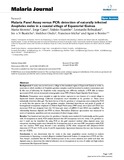Malaria panel assay versus PCR: detection of naturally infected Anopheles melas in a coastal village of Equatorial Guniea.

View/
Date
2004Author
Moreno, M
Cano, J
Nzambo, S
Bobuakasi, L
Buatiche, J N
Mukabana, W R
Fox-Rushby, J
Type
ArticleLanguage
enMetadata
Show full item recordAbstract
Background: A study was carried out in a village of the mainland region of Equatorial Guinea in order to
ascertain a) which members of Anopheles gambiae complex could be involved in malaria transmission and
b) the rate of infectivity for Anopheles melas comparing two different methods, a PCR able to detect
sporozoite-DNA and an immunochromatographic assay MPR (Malaria Rapid Dipstick Panel Assay).
Methods: Mosquitoes were sampled at night by indoor captures in two houses of a coastal village in
Equatorial Guinea (Ayantang). Collected mosquitoes were identified as An. gambiae s.l. These were
individually dried into silica-gel. The head-thorax of the An. gambiae s.l. mosquitoes were analysed by PCR
to verify that the species was of the gambiae complex. Individual head-thorax and pools (5 pools) of
homogenized mosquitoes employed in Malaria Rapid Panel assay (MRP assay) were lysed and DNA was
extracted. PCR was designed from the 753 base pair insert of pBRKl-14 and DNA was amplified. The
relationship between dipstick and PCR to detect Plasmodium falciparum sporozoites was measured in
terms of sensitivity, specificity and test association (Cohen's kappa value).
Results: Two hundred and sixty-four An. gambiae s.l. females were studied (214 individually and five pools
with 10 mosquitoes in each). PCR analysis showed that 207 mosquitoes were An. melas, 3 An. gambiae s.s.
and 4 could not be identified. By using PCR as the gold standard method when dipstick assay was
compared, matching results were obtained for 6 mosquitoes and, in one case MRP was positive while PCR
was not reactive. MRP assay showed a low sensitivity (3.3%) when compared with falciparum-DNA
detection (17,7% and 14,3%, series A and B respectively). Agreement between the two test formats was
low (κ = 0,224).
Conclusion: It was determined that An. melas is the main anopheline vector involved in malaria
transmission in Ayantang, a coastal village in mainland Equatorial Guinea. A comparison of PCR and Vec-
Test Assay®, concluded that the PCR method proved to be a more sensitive and useful tool than the
dipstick assay to determine the malarial infection rate in mosquitoes in an area of stable and high malaria
transmission like Equatorial Guinea.
Citation
Moreno, M., Cano, J., Nzambo, S., Bobuakasi, L., Buatiche, J. N., Mukabana, W. R., ... & Fox-Rushby, J. (2004). Malaria panel assay versus PCR: detection of naturally infected Anopheles melas in a coastal village of Equatorial Guniea. Malaria Journal, 3(20), 6.Publisher
University Of Nairobi
